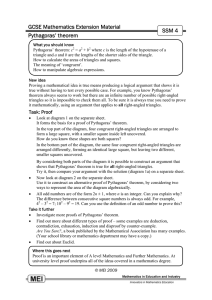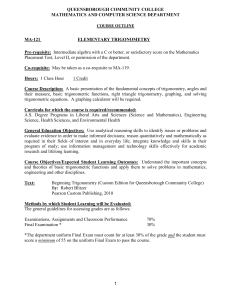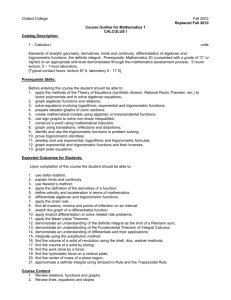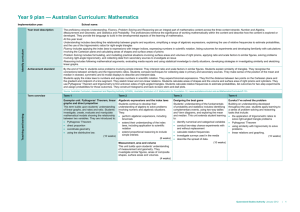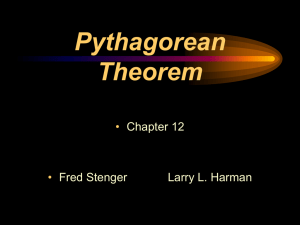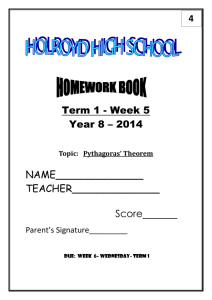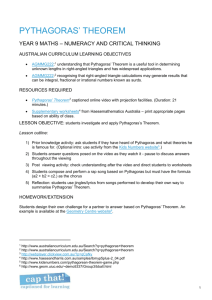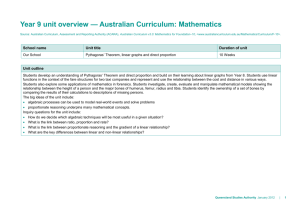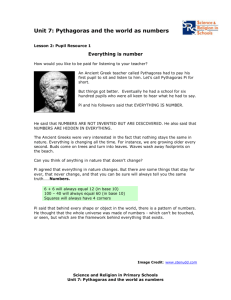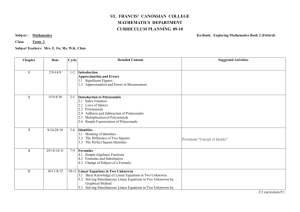ac_maths_yr9_plan - Rosebery District High School
advertisement
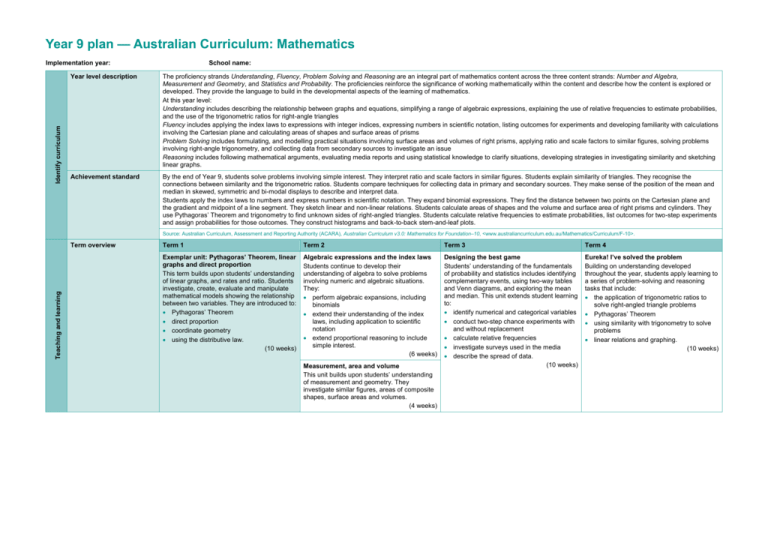
Year 9 plan — Australian Curriculum: Mathematics Identify curriculum Implementation year: School name: Year level description The proficiency strands Understanding, Fluency, Problem Solving and Reasoning are an integral part of mathematics content across the three content strands: Number and Algebra, Measurement and Geometry, and Statistics and Probability. The proficiencies reinforce the significance of working mathematically within the content and describe how the content is explored or developed. They provide the language to build in the developmental aspects of the learning of mathematics. At this year level: Understanding includes describing the relationship between graphs and equations, simplifying a range of algebraic expressions, explaining the use of relative frequencies to estimate probabilities, and the use of the trigonometric ratios for right-angle triangles Fluency includes applying the index laws to expressions with integer indices, expressing numbers in scientific notation, listing outcomes for experiments and developing familiarity with calculations involving the Cartesian plane and calculating areas of shapes and surface areas of prisms Problem Solving includes formulating, and modelling practical situations involving surface areas and volumes of right prisms, applying ratio and scale factors to similar figures, solving problems involving right-angle trigonometry, and collecting data from secondary sources to investigate an issue Reasoning includes following mathematical arguments, evaluating media reports and using statistical knowledge to clarify situations, developing strategies in investigating similarity and sketching linear graphs. Achievement standard By the end of Year 9, students solve problems involving simple interest. They interpret ratio and scale factors in similar figures. Students explain similarity of triangles. They recognise the connections between similarity and the trigonometric ratios. Students compare techniques for collecting data in primary and secondary sources. They make sense of the position of the mean and median in skewed, symmetric and bi-modal displays to describe and interpret data. Students apply the index laws to numbers and express numbers in scientific notation. They expand binomial expressions. They find the distance between two points on the Cartesian plane and the gradient and midpoint of a line segment. They sketch linear and non-linear relations. Students calculate areas of shapes and the volume and surface area of right prisms and cylinders. They use Pythagoras’ Theorem and trigonometry to find unknown sides of right-angled triangles. Students calculate relative frequencies to estimate probabilities, list outcomes for two-step experiments and assign probabilities for those outcomes. They construct histograms and back-to-back stem-and-leaf plots. Source: Australian Curriculum, Assessment and Reporting Authority (ACARA), Australian Curriculum v3.0: Mathematics for Foundation–10, <www.australiancurriculum.edu.au/Mathematics/Curriculum/F-10>. Teaching and learning Term overview Term 1 Term 2 Term 3 Term 4 Exemplar unit: Pythagoras’ Theorem, linear graphs and direct proportion This term builds upon students’ understanding of linear graphs, and rates and ratio. Students investigate, create, evaluate and manipulate mathematical models showing the relationship between two variables. They are introduced to: Pythagoras’ Theorem direct proportion coordinate geometry using the distributive law. (10 weeks) Algebraic expressions and the index laws Students continue to develop their understanding of algebra to solve problems involving numeric and algebraic situations. They: perform algebraic expansions, including binomials extend their understanding of the index laws, including application to scientific notation extend proportional reasoning to include simple interest. (6 weeks) Designing the best game Students’ understanding of the fundamentals of probability and statistics includes identifying complementary events, using two-way tables and Venn diagrams, and exploring the mean and median. This unit extends student learning to: identify numerical and categorical variables conduct two-step chance experiments with and without replacement calculate relative frequencies investigate surveys used in the media describe the spread of data. (10 weeks) Eureka! I’ve solved the problem Building on understanding developed throughout the year, students apply learning to a series of problem-solving and reasoning tasks that include: the application of trigonometric ratios to solve right-angled triangle problems Pythagoras’ Theorem using similarity with trigonometry to solve problems linear relations and graphing. (10 weeks) Measurement, area and volume This unit builds upon students’ understanding of measurement and geometry. They investigate similar figures, areas of composite shapes, surface areas and volumes. (4 weeks)
